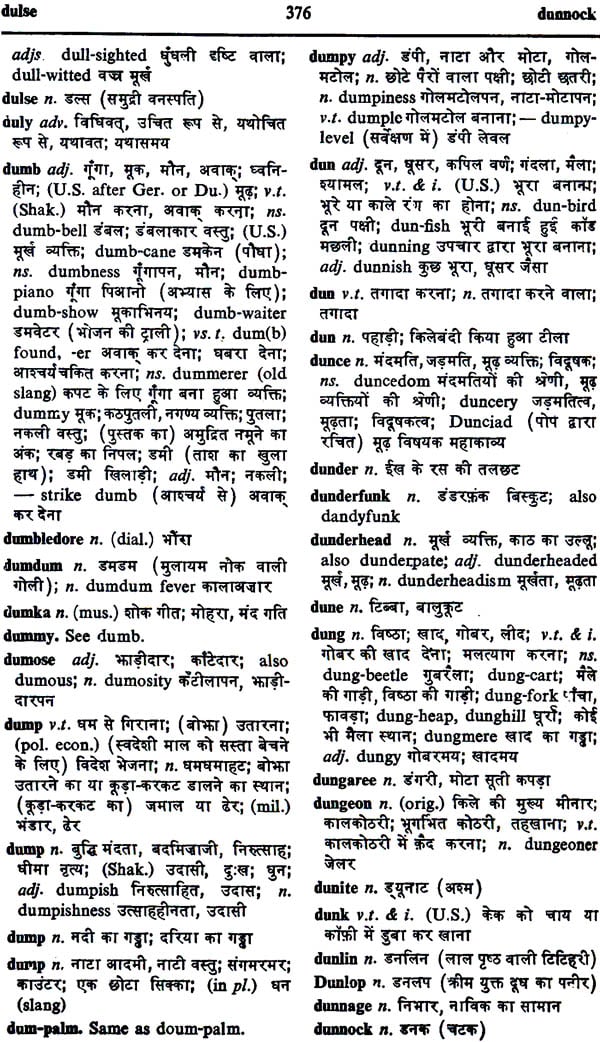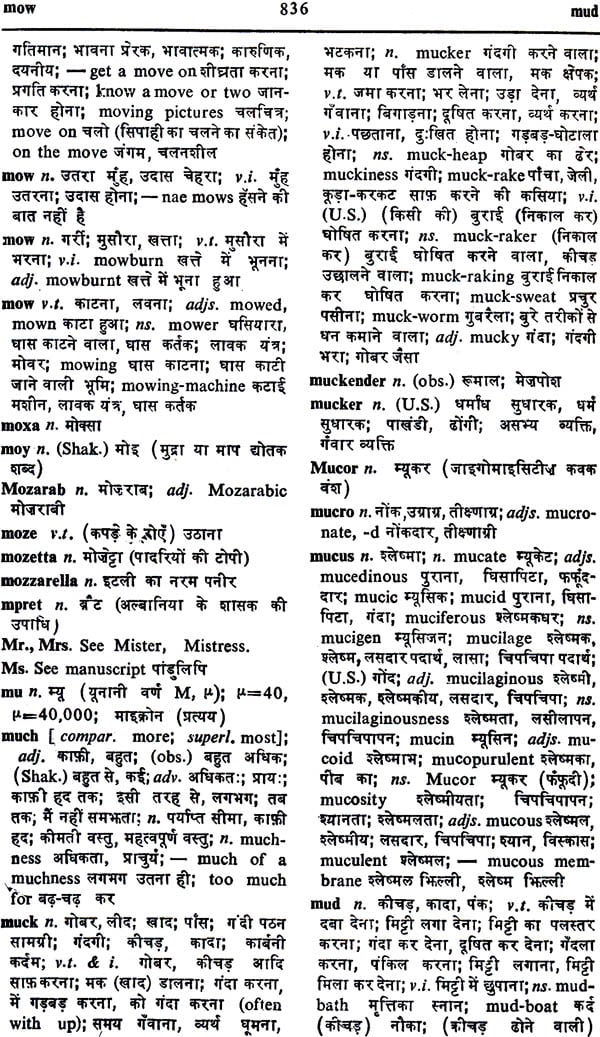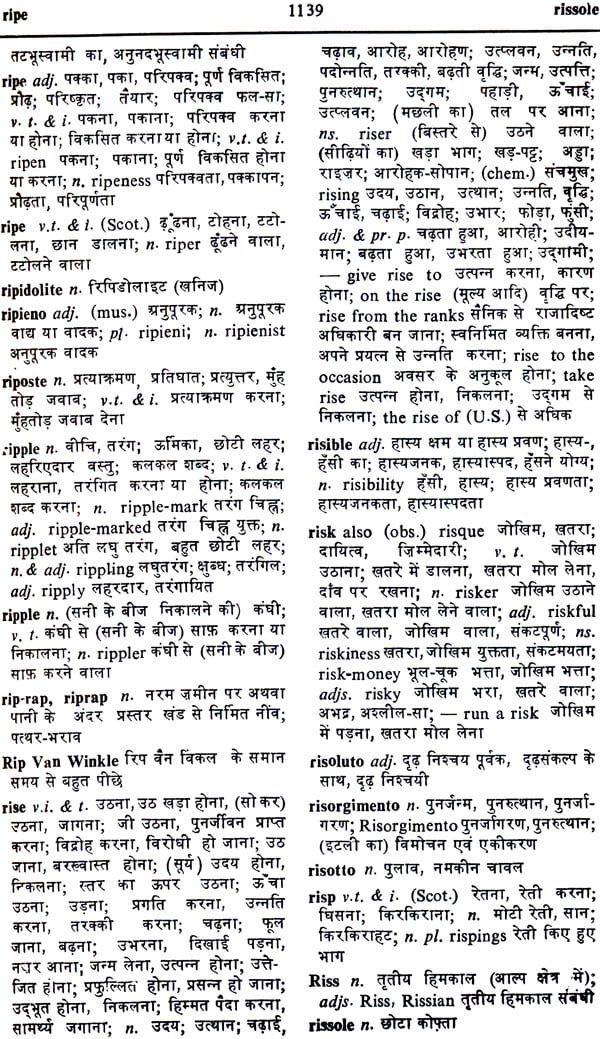
Chambers English Hindi Dictionary (Nineteenth Edition)
Book Specification
| Item Code: | NAC111 |
| Author: | Dr. Suresh AwasthiDr. Induja Awasthi |
| Publisher: | Allied Publishers Pvt. Limited |
| Edition: | 2009 |
| Pages: | 1623 |
| Cover: | Hardcover |
| Other Details | 8.8 Inch X 5.8 Inch |
| Weight | 1.55 kg |
Book Description
During the last thirty years a number of English-Hindi dictionaries have been brought out to meet the growing demand. Despite this fast multiplying lexicographical literature, no sound principles and methods have been discernible in these efforts for the preparation of English Hindi bilingual dictionaries The task of the lexicographer in the preparation of bilingual dictionary has become difficult and complex, because of the unprecedented growth of Hindi vocabulary, especially in regard to science, technology and humanities The mixed character of Hindi vocabulary and the lack of standardised usage makes the task of the lexicographer all the more difficult in coordinating the lexical units of the source language (English) with the target language (Hindi). It is in this Context that ‘Chambers English-Hindi Dictionary’ acquires a special significance.
It is for the first time that an English-Hindi Dictionary has been prepared based on any one standard English-English dictionary. Most of the compilers of English-Hindi dictionaries, because of the problem of the copyright, have to select English words for entries and in the selection they fail to adept any uniform pattern. Also Chambers Twentieth Century Dictionary has a most comprehensive and broad-based vocabulary, incorporating latest words in its edition of 1977 published by the Allied Publishers, which has been the basis for this bilingual Dictionary.
We have followed the principles and methods of lexicography as evolved by the Central Hindi Directorate in their lexical work: Hindi equivalents for the scientific and technical terms have been taken from the terminological glossaries prepared by the Directorate and published in 1974. Thus, it is the first bhingual Dictionary giving the latest and most up-to-date Hindi equivalents for scientific and technical terms. This we thought will help the popularization of standard terminology, and also make the Dictionary more acceptable in educational circles and government departments. Such an approach will also help the teachers and students of science subjects and the translators of scientific literature- in several cases, especially in regard to the non-conceptual scientific and technical terms, the original forms have been retained and rendered in Devanagari script, often along with the newly-coined Hindi equivalents this reflects the bilingual character of the technical terminology.
Hindi equivalents:
In selecting Hindi equivalents our main criterion has been the frequency of the Hindi word. In case of more than one equivalent for an English word, their order has also been fixed based on frequency. Current and simpler words have been given first, followed by the literary and newly-coined words.
Effort has been made to give precise Hindi equivalents rather than giving definitions and explanations. At the present stage of Hindi vocabulary, there is no precision in usage; but in the context of the growing tendency of the vocabulary towards standardization, we have attempted fixation of words, determined by and based on usage. This we thought will be helpful to the users of the Dictionary.
The meanings and the sense-division is in accordance with and in the same order as in Chambers English Dictionary. In some cases, however, the order has been changed to take up the current meaning first, and the historical meaning afterwards.
The transitive and intransitive shades of meanings have not been indicated separately. In the case of all such English words, which are both transitive and intransitive, the grammatical category has been mentioned as v i. & t. or Vt. & 1. in the beginning, according to the preference, and the corresponding Hindi shades have been provided according to the necessity of the sense-division. This has been done to suit the genius of Hindi language, in which unlike English, the same word but with different grammatical form, covers the meanings of both the transitive and intransitive shades. In such cases, where a phrase had to be given for an English word, while the main word has been given as primary equivalent, parenthetical words have been put within the brackets before the equivalent or after it, following the natural structure of Hindi language.
We have tried to follow uniform spellings of Hindi words; but in view of certain flexibility in this regard, we have not been rigid about it. It is not the function of a lexicographer to impose standardization; his job is to follow the prevalent tendencies of the language at a given time.
Word categories omitted
(a) Archaic and obsolete words, forms and meanings. Most of the slangs and colloquial forms have, however, been retained.
(b) Dialectical forms, words and meanings.
(c) The forms and meanings shown against specific English writers like Browning, Milton, etc. (except some important forms and meanings shown against Shakespeare, Spencer).
(d) Most of the words and meanings covered under the subject label Heraldry and Christianity.
(e) Words of Indian origin, especially Sanskrit and Hindi words which have gained currency in English.
Grammatical categories omitted
(a) The past tense and past participle forms.
(b) The adjectives formed by adding - ing (e g. bathing), unless they denote a different shade of meaning.
(c) The adverbial forms of the words (e.g. happily, strongly), unless they denote a different shade of meaning (e.g. shortly).
(d) -z and the -ize forms.
In Hindi these forms are expressed on the basis of the main words, and a separate equivalent is not required. Sonic other similar measures have been taken to suit the genius and structure of Hindi language.
The following are some other measures of editorial work
(a) Etymological descriptions have been omitted.
(b) Of the status labels only slang, colloquial and U.S. forms have been retained.
(c) ‘Words indicating variant or archaic forms of spellings have normally been omitted, unless they are frequent (e.g. ‘enquiry’ and ‘inquiry’ both have been retained ; but ‘catch up’, ‘catsup’ have been deleted and only ‘ketchup’ has been retained).
The pronunciation of word entries have not been given. Wherever the English word current in Hindi as such has been ‘named, the Devanagari transcription generally corresponds to the pronunciation, as given in the English-English Dictionary. It was felt that any attempt to give the pronunciation of all English words in Devanagari script even by using complex diacritical marks will only be misleading, and also this is not the function of a bilingual dictionary.
(d) Latin and French words and phrases in vogue in English have been retained as separate entries. The grammatical categories of such words have not been mentioned as in English-English Dictionary.
(e) The grammatical categories or functional labels have been given in English in abbreviated forms as in Chambers English-English Dictionary.
(f) Subject labels have been given in English abbreviation as in Chambers Dictionary (i.e. bot. and not botany) and not in their Hindi forms.
(g) Since most of the generic and species names pertaining to Botany and Zoology have been retained as such and rendered in Devanagari script without giving their explanations, the generic and species names have also been given in brackets. As far as the terms pertaining to Geology and Chemistry are concerned, their subjects have been given in brackets.
(h) Unlike English-English Dictionary, sub-entries whether in simple or compound forms have been arranged alphabetically. However, all phrases have followed these sub-entries which are also in alphabetical order.
Punctuation marks and setting:
(a) In order to make the use of the Dictionary easier, the whole system of punctuation marks has been simplified. There is no punctuation mark after the English word, and also at the end of each entry. However, a dot has been given after grammatical specifications and abbreviations.
(b) Comma has been used to separate multiple equivalents of the same meaning, and semicolon between the equivalents representing shades of meaning.
(c) The compound words as well as the phrases under a single entry have been given in a running para. The phrases have been preceded by dash without any grammatical category or-functional label.
In compiling and preparing this Dictionary we have utilised our experience of over fifteen years of terminological and lexicographical work in the Central Hindi Directorate. Though the work on the Dictionary was started in early seventies, but for various reasons, both its preparation and publication got delayed; and it is reaching the hands of the users only in 1980. But that in no way has affected the quality of the work Full care has been taken to revise the material and make it up to date before going to the press.
We are grateful to many of our former colleagues Sarvashri D.N. Pant, Shri Bharat Bhushan, Dr. S.B. Singh and Dr. Narendra Vyas but for whose cooperation and help it would not have been possible to take up and complete this gigantic task. Shri Bharat Bhushan went through the whole manuscript and helped in coordination. Dr. Vyas has been of great help during the revision and printing of the Dictionary.
Finally, I would like to express my appreciation of the patience shown by Shri RN. Sachdev, Managing Director of the Allied Publishers. Mr. Sachdev has plans to bring out several specialised dictionaries, such as: Allied English-Hindi Pocket Dictionary; Allied English-Hindi Students Dictionary and Allied English-Hindi Technical Dictionary. After leaving the Hindi Directorate in 1965 to join the Sangeet Natak Akademi as its Secretary, my field of activity was totally changed. Since then, I have been deeply involved in the study and teaching of theatre and allied arts. This Dictionary is the result of my work and experience in the Central Hindi Directorate, and in that regard. I have a sense of fulfilment.








